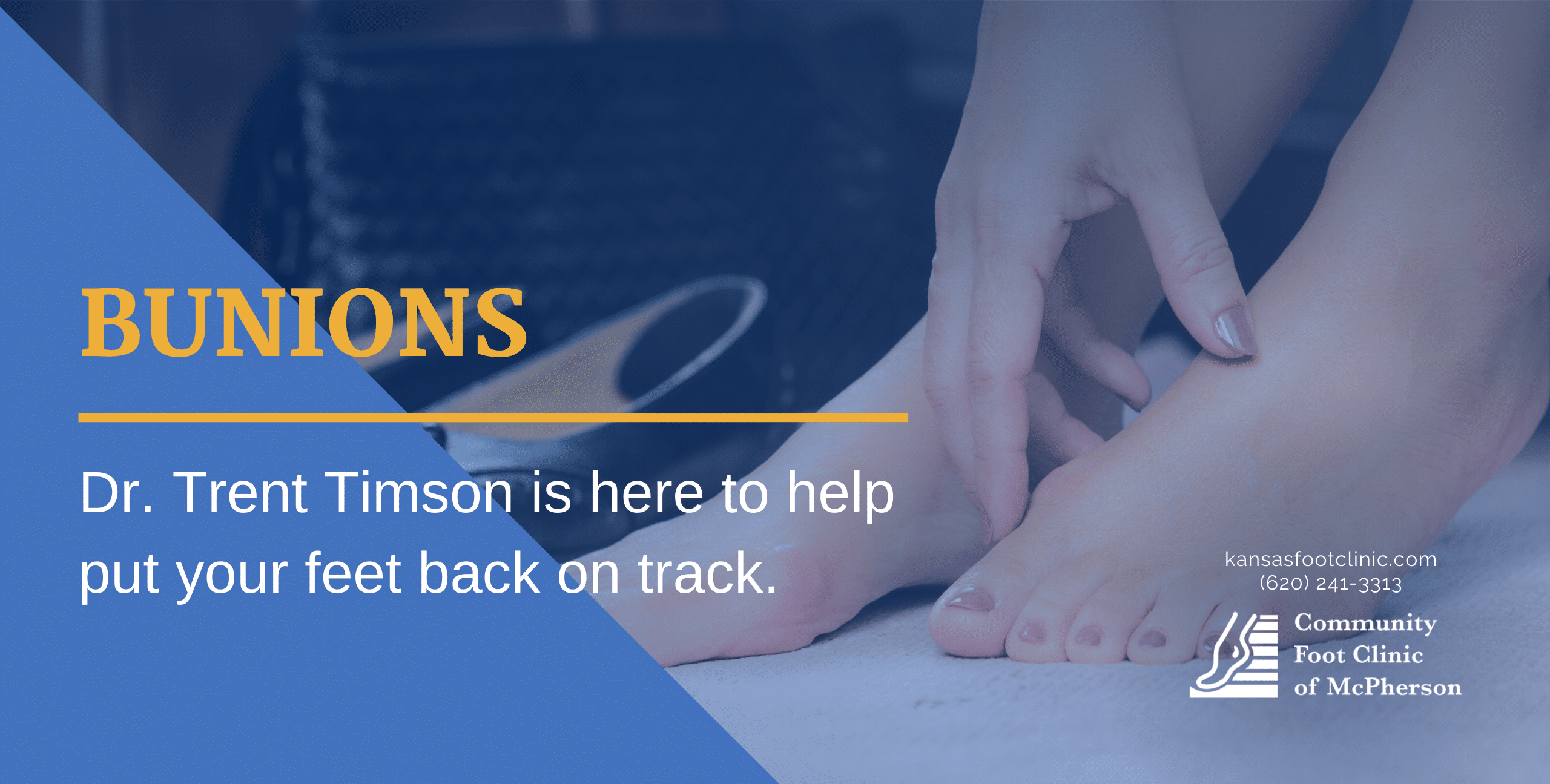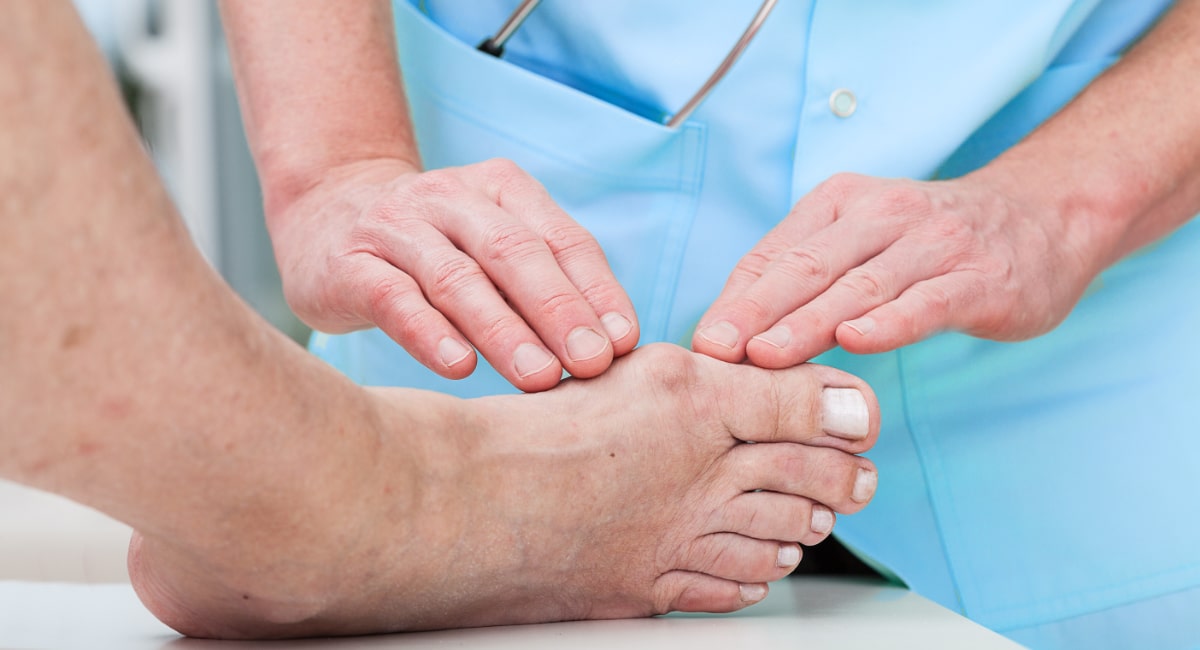Bunions
Feet come in all shapes and sizes and given the amount of force they endure every day, they’re always changing! One of the most common indicators that your feet are changing is the appearance of bunions.
What Is a Bunion?
You know when bunions are there, but what exactly are they? Bunions are a common foot deformity in which two things happen:
A bony bump forms on the side of your foot where the big toe connects with the rest of the foot.
The toe itself gets “pushed” out of alignment, to the point where it’s colliding with (or even crossing over) the second toe.
Even if it isn’t causing too many problems for you, bunions can become very painful and swollen over time. At this point, they can impede walking, standing, or even just fitting into a pair of shoes. The longer you go without treatment, the worse a bunion gets.

Causes of Bunions – It’s Not Always About Shoes!
It’s a common misconception that bunions only occur in middle-aged and older women. While women make up about 90 percent of all cases, bunions can occur in men and even children, too.
In many cases, it may be that your natural foot shape doesn’t distribute pressure evenly across your foot, and excess weight and force slowly push your toe out of alignment. Injuries and inflammatory arthritis could also contribute to the condition.
High-heeled shoes (or other shoes that either cramp toes or place extra weight on the front of the foot) are correlated with a greater risk of bunion formation when worn frequently and for extended periods. There’s some debate whether shoes can cause bunions in a healthy foot, or if they just make existing problems worse. In either case, these types of shoes should be avoided as much as possible.
Treating Bunions Without Surgery
As with many other foot conditions, our first choice is to manage bunions non-invasively. It’s important to understand that this isn’t a fix – the bump will still be there. But it can often allow you to return to normal activity without pain, as well as slow—and even stop—progression of the deformity.
Managing bunions without surgery involve properly aligning the foot. Since bunions are caused by uneven pressure on the foot, our strategy is to rebalance those forces away from the unstable metatarsal joint, through methods such as:
- Switching to roomier and more comfortable shoes.
- Taping or splinting the toe into its normal position.
- Using shoe inserts or custom orthotics that properly cushion and support your foot.
- Placing padding along sensitive areas to minimize painful friction and avoid complications such as corns or blisters.
If you still have some minor pain and swelling, over-the-counter painkillers and applying ice can be beneficial. We can also provide cortisone shots or other remedies for stronger discomfort.
In severe cases, however, surgery may be necessary. And if that becomes the case for you, then you can find comfort in knowing that you are in good hands here at Community Foot Clinic of McPherson. We will thoroughly discuss what surgery will look like so you can feel confident about moving forward with treatment.

Surgical Bunion Correction – Is It for You?
The truth of the matter is that surgery is the only way to restore a foot to its “normal” shape. Although we try to avoid it, sometimes surgery is simply the only option. You may want to consider it if your bunion is severe and conservative treatments aren’t helping.
We offer several surgical procedures for you to choose from, based on the severity of your bunion. We will also consider age, health, lifestyle or work commitments, or personal goals to find the right surgery for your needs.
One type of surgery with which we’ve seen great success is Lapiplasty Bunion Surgery. With precise incisions and specialized tools, Lapiplasty enables us to provide complete anatomical correction to your foot.
The surgery involves repositioning the metatarsal to its original position. While the metatarsal is held in its ideal configuration, we’ll then cut and reshape the bone as needed. Once that is complete, thin titanium plates are permanently placed to keep everything in place and promote the natural healing process.
In addition to anatomical correction, some of the other benefits of Lapiplasty Bunion Surgery include a faster healing time than other methods, which gets you back on your feet faster. As well, due to the corrective nature of the procedure, the chances of bunions forming again are very slim.
Treat Your Bunions Today
We’ll make sure to talk through all your options with you clearly and carefully so that you can make an informed decision. Whatever procedure you choose, we’ll do our best to minimize scarring and help you recover as quickly as possible.
Again, with bunions, it’s best not to delay treatment. The sooner we see you, the more likely we can help without the need for surgery.
To make an appointment at our office, please fill out our online contact form or give us a call at (620) 241-3313 today.
McPherson Office
316 W. 4th Street
McPherson, KS 67460
P: (620) 241-3313
F: (620) 241-6967
© Community Foot Clinic of McPherson. All Rights Reserved.
Privacy Policy | Terms & Conditions
Web Design by CP Solutions
Marketed by VMD Services
